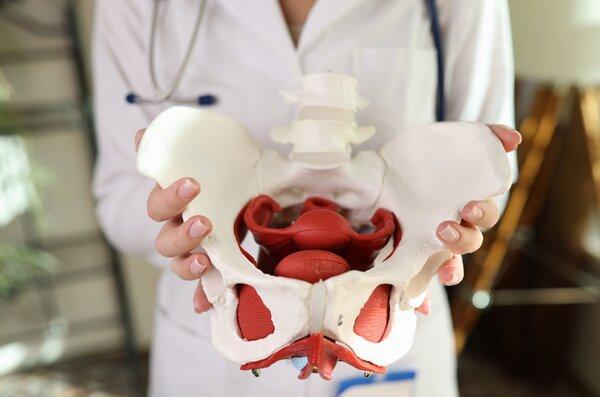
(Note: Some of the links in this post are affiliate links, and we will be compensated when you make a purchase by clicking through our links at no additional cost to you.)
Understanding the Signs of a Dysfunctional Pelvic Floor: Symptoms and Solutions
Our bodies are a masterpiece of complex systems working harmoniously to keep us healthy and functioning. One crucial yet often overlooked component is the pelvic floor – a group of muscles and tissues that provide essential support to our core, bladder, uterus, and rectum. When the pelvic floor functions well, we hardly notice it. However, when it becomes dysfunctional, it can lead to a range of uncomfortable symptoms. In this article, we’ll delve into the world of the pelvic floor, exploring the signs of dysfunction and offering insights into potential solutions.
What is the Pelvic Floor?
Before we dive into the symptoms, let’s understand the pelvic floor’s role in our bodies. The pelvic floor is a network of muscles, ligaments, and tissues that stretch across the bottom of the pelvis like a hammock. It plays a vital role in supporting our internal organs, maintaining continence, and even influencing sexual function.
Imagine the pelvic floor as a trampoline – it should be flexible, yet strong enough to bear the weight it carries. When this balance is disrupted, it can lead to a range of issues.

Image Credit: Wikipedia
Symptoms of a Dysfunctional Pelvic Floor
- Urinary Incontinence: One of the most common signs of a dysfunctional pelvic floor is urinary incontinence. This can manifest as leakage when laughing, sneezing, coughing, or even exercising. Weak pelvic floor muscles struggle to keep the bladder closed, leading to unintentional urine leakage.
- Frequent Urination: If you find yourself rushing to the bathroom more frequently than usual, it might be a sign of a dysfunctional pelvic floor. Overactive or spasming pelvic floor muscles can cause the sensation of needing to urinate even when the bladder isn’t full.
- Pelvic Pain: Discomfort or pain in the pelvic region can indicate pelvic floor dysfunction. This pain might be constant or only occur during certain activities, like sitting for extended periods or during sexual intercourse.
- Painful Intercourse: Pain during sex, known as dyspareunia, can be linked to a dysfunctional pelvic floor. Tense or tight pelvic floor muscles can make intercourse painful and uncomfortable.
- Constipation: Struggling with frequent constipation or difficulty emptying your bowels could be a sign of pelvic floor dysfunction. Weak muscles in this area can make it challenging for the rectum to function properly.
- Pelvic Organ Prolapse: In some cases, a dysfunctional pelvic floor can lead to pelvic organ prolapse. This occurs when the organs in the pelvis, such as the uterus or bladder, descend into the vaginal canal due to inadequate support from the pelvic floor muscles.
- Lower Back Pain: The pelvic floor is closely connected to the lower back muscles. Dysfunction in the pelvic floor can contribute to lower back pain, as the two areas work in tandem to support the spine and core.
Causes of Pelvic Floor Dysfunction
Several factors can contribute to pelvic floor dysfunction:
- Pregnancy and Childbirth: The pelvic floor undergoes significant stress during pregnancy and childbirth, which can lead to weakened muscles.
- Lifestyle Choices: Factors such as obesity, heavy lifting, and a sedentary lifestyle can strain the pelvic floor muscles.
- Age: As we age, the muscles and tissues in the pelvic floor can naturally weaken.
- Chronic Straining: Chronic constipation, persistent coughing, or heavy lifting can strain the pelvic floor and lead to dysfunction.
- High-Impact Exercises: Intense exercises like running and jumping can place stress on the pelvic floor if not executed correctly.
- Hormonal Changes: Hormonal fluctuations, especially during menopause, can impact the health of pelvic floor tissues.
Addressing Pelvic Floor Dysfunction
The good news is that a dysfunctional pelvic floor can often be improved with appropriate interventions:
- Pelvic Floor Exercises: Also known as Kegel exercises, these targeted movements aim to strengthen and tone the pelvic floor muscles. Identifying the right muscles to engage is essential. Imagine stopping the flow of urine midstream – those are the muscles you’re targeting.
- Physical Therapy: Pelvic floor physical therapy involves working with a specialist who can guide you through exercises that help relax or strengthen specific muscles. This personalized approach can yield significant improvements.
- Lifestyle Modifications: Maintaining a healthy weight, avoiding heavy lifting, and practicing good posture can reduce strain on the pelvic floor.
- Dietary Adjustments: A diet rich in fiber can promote regular bowel movements, reducing the strain on pelvic floor muscles during bowel movements.
- Bladder Training: If overactive bladder is an issue, a pelvic floor physical therapist can guide you through bladder training techniques to improve control.
- Relaxation Techniques: Chronic tension in the pelvic floor can be alleviated with relaxation techniques such as deep breathing, yoga, and meditation.
- Surgical Options: In severe cases, where other interventions don’t yield results, surgical procedures might be considered to repair or support the pelvic floor.
Our pelvic floor is an intricate network of muscles that deserves our attention and care. Recognizing the symptoms of dysfunction and taking proactive steps to address them can lead to a significant improvement in one’s quality of life. Whether through exercises, therapy, or lifestyle adjustments, there’s a path to healing and restoring the balance of this vital part of our body. If you suspect you’re experiencing pelvic floor dysfunction, don’t hesitate to seek guidance from a healthcare professional who can provide tailored advice based on your specific needs.






